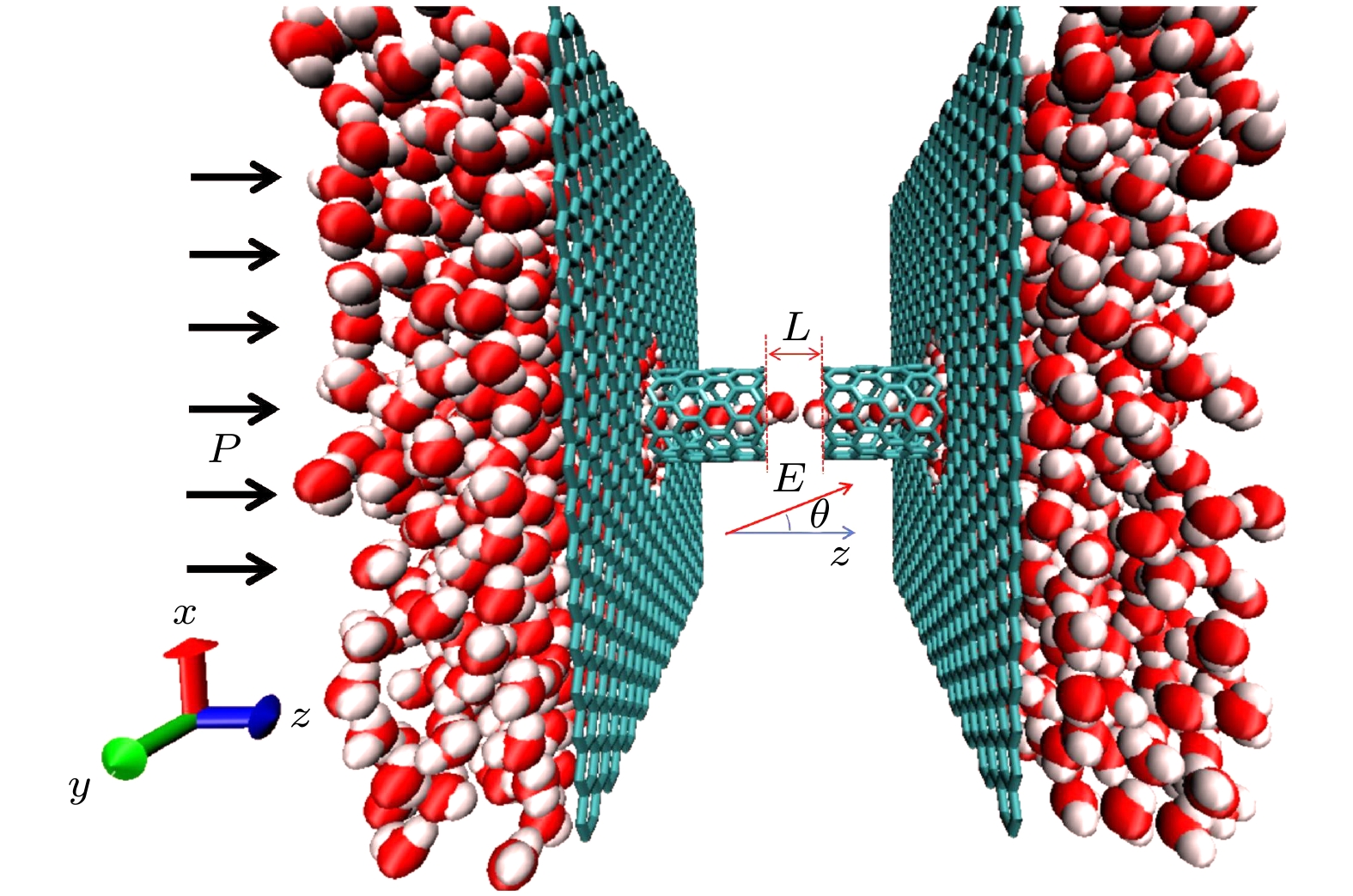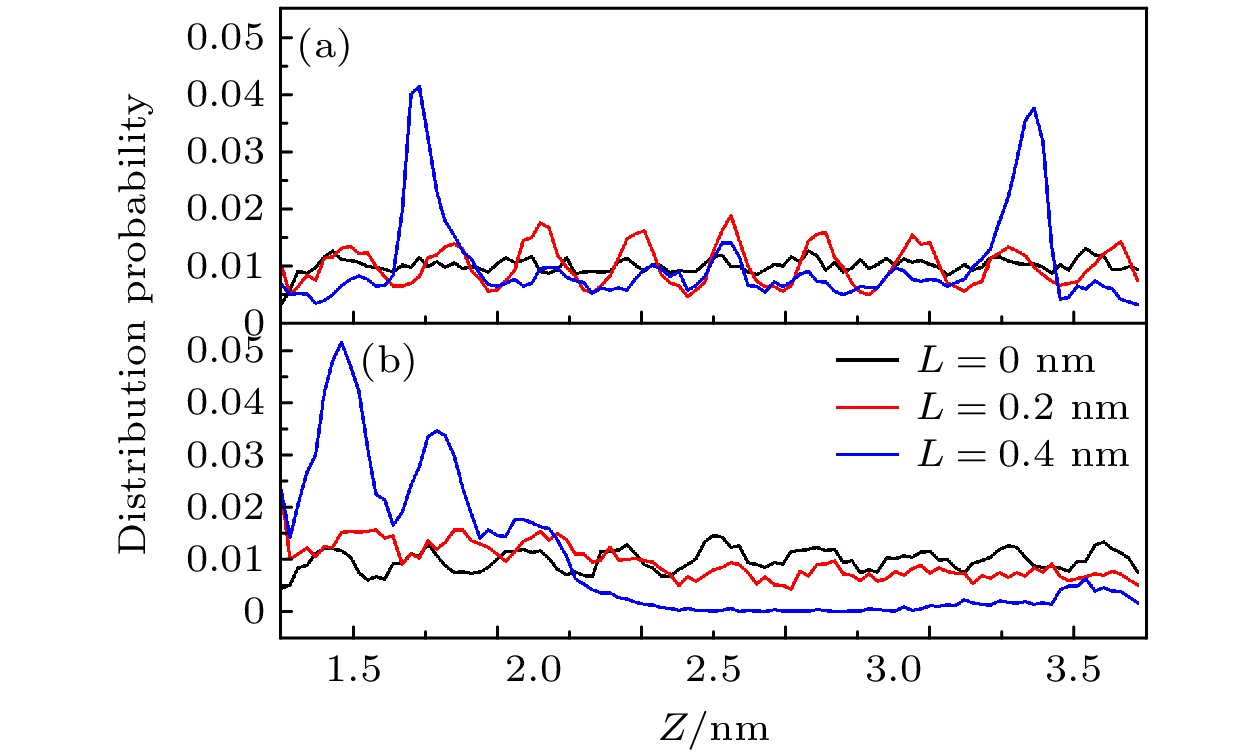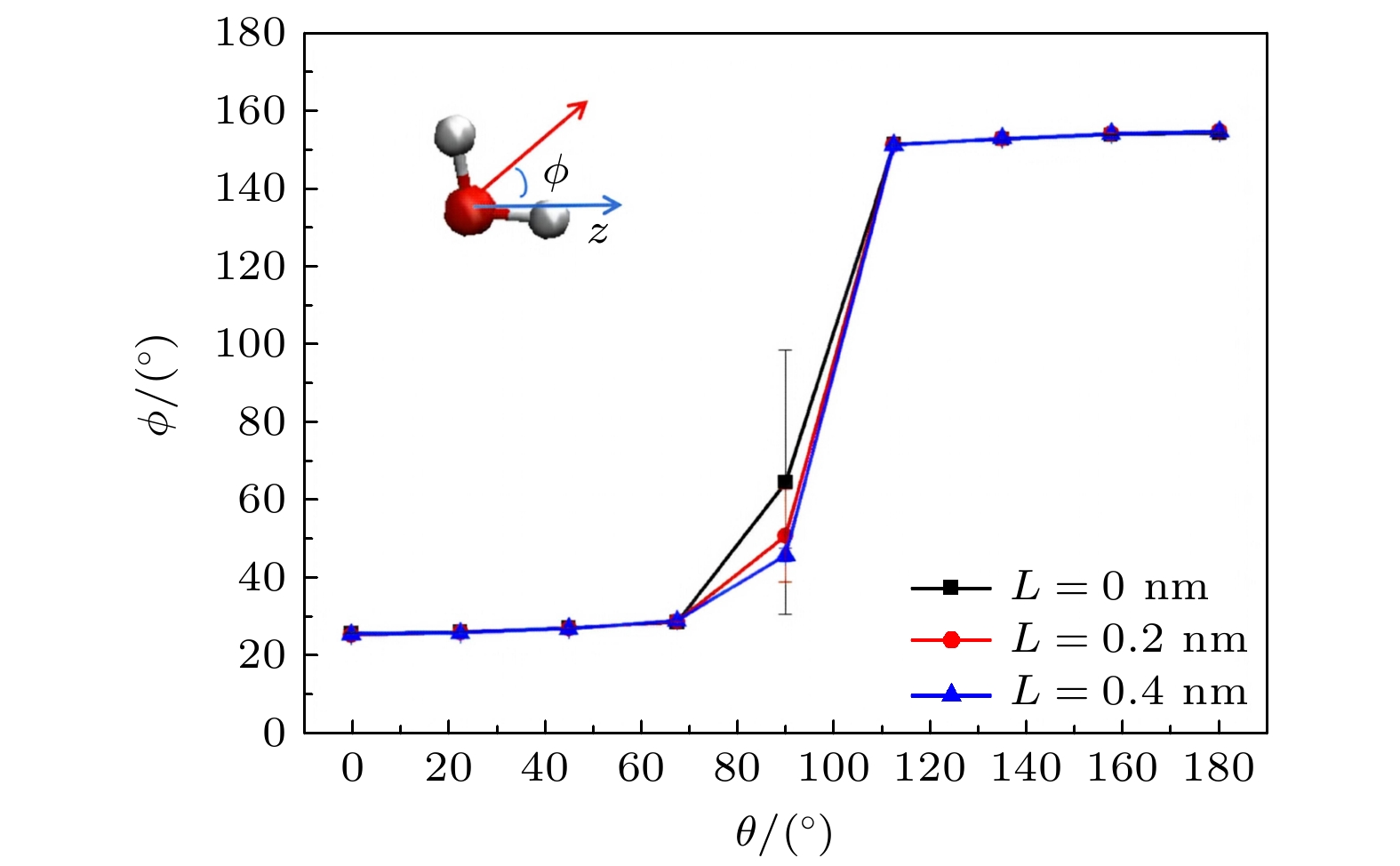-
The orientation of water molecules within nanochannels is pivotal in influencing water transport, particularly under the influence of electric fields. This study delves into the effects of electric field direction on water transport through disjoint nanochannels, a structure which is of emerging significance. Molecular dynamics simulations are conducted to study the properties of water in complete nanochannel and disjoint nanochannels with gap sizes of 0.2 nm and 0.4 nm, respectively, such as occupancy, transport, water bridge formation, and dipole orientation, by systematically varying the electric field direction from 0 to 180 degrees. The simulation results disclose that the electric field direction has little influence on water flow through complete nanochannels. However, as the size of the nanogap expands, the declining trend of water transfer rate through disjoint nanochannels becomes more distinctive when the electric field direction is shifted from 0 to 90 degrees under an electric field with a strength of 1 V/nm. Notably, results also reveal distinct behaviors at 90 degrees under an electric field with a strength of 1 V/nm, where the stable water chains, unstable water bridges, and no water bridges are observed in complete nanochannels, disjoint nanochannels with 0.2 nm gap, and 0.4 nm gap, respectively. Moreover, simulations indicate that increasing the electric field strength in a polarization direction perpendicular to the tube axis facilitates water bridge breakdown in disjoint nanochannels. This research sheds light on the intricate interplay between electric field direction and water transport dynamics in disjoint nanochannels, presenting valuable insights into various applications.
-
Keywords:
- electric field /
- disjoint nanochannels /
- direction
[1] Fajardo-Diaz J L, Morelos-Gomez A, Cruz-Silva R, Ishii K, Yasuike T, Kawakatsu T, Yamanaka A, Tejima S, Izu K, Saito S, Maeda J, Takeuchi K, Endo M 2022 Chem. Eng. J. 448 137359
 Google Scholar
Google Scholar
[2] Kang X, Meng X W 2022 Chem. Phys. 559 111544
 Google Scholar
Google Scholar
[3] Corry B 2008 J. Phys. Chem. B 112 1427
 Google Scholar
Google Scholar
[4] Zhang R N, Liu Y N, He M R, Su Y L, Zhao X T, Elimelech M, Jiang Z Y 2016 Chem. Soc. Rev. 45 5888
 Google Scholar
Google Scholar
[5] Werber J R, Osuji C O, Elimelech M 2016 Nat. Rev. Mater. 1 16018
 Google Scholar
Google Scholar
[6] Abramyan A K, Bessonow N M, Mirantsev L V, Chevrychkina A A 2018 Eur. Phys. J. B 91 48
 Google Scholar
Google Scholar
[7] Park H G, Jung Y 2014 Chem. Soc. Rev. 43 565
 Google Scholar
Google Scholar
[8] 孙志伟, 何燕, 唐元政 2021 70 060201
 Google Scholar
Google Scholar
Sun Z W, He Y, Tang Y Z 2021 Acta Phys. Sin. 70 060201
 Google Scholar
Google Scholar
[9] Qiu T, Meng X W, Huang J P 2015 J. Phys. Chem. B 119 1496
 Google Scholar
Google Scholar
[10] Holt J K, Park H G, Wang Y M, Stadermann M, Artyukhin A B, Grigoropoulos C P, Noy A, Bakajin O 2006 Science 312 1034
 Google Scholar
Google Scholar
[11] Hummer G, Rasaiah J C, Noworyta J P 2001 Nature 414 188
 Google Scholar
Google Scholar
[12] Secchi E, Marbach S, Nigues A, Stein D, Siria A, Bocquet L 2016 Nature 537 210
 Google Scholar
Google Scholar
[13] Farrokhbin M, Lohrasebi A 2023 Eur. Phys. J. E 46 93
 Google Scholar
Google Scholar
[14] He Y C, Sun G, Koga K, Xu L M 2014 Sci. Rep. 4 6596
 Google Scholar
Google Scholar
[15] Liu W C, Jing D W 2023 J. Phys. Chem. Lett. 14 5740
 Google Scholar
Google Scholar
[16] Wang Y, Zhao Y J, Huang J P 2011 J. Phys. Chem. B 115 13275
 Google Scholar
Google Scholar
[17] Zhang Q L, Yang R Y, Jiang W Z, Huang Z Q 2016 Nanoscale 8 1886
 Google Scholar
Google Scholar
[18] Zhang Q L, Yang R Y 2016 Chem. Phys. Lett. 644 201
 Google Scholar
Google Scholar
[19] Zhu J Z, Lan Y Q, Du H J, Zhang Y H, Su J G 2016 Phys. Chem. Chem. Phys. 18 17991
 Google Scholar
Google Scholar
[20] Shafiei M, Von Domaros M, Bratko D, Luzar A 2019 J. Chem. Phys. 150 074505
 Google Scholar
Google Scholar
[21] Vanzo D, Luzar A, Bratko D 2021 Phys. Chem. Chem. Phys. 23 27005
 Google Scholar
Google Scholar
[22] 张忠强, 李冲, 刘汉伦, 葛道晗, 程广贵, 丁建宁 2018 67 056102
 Google Scholar
Google Scholar
Zhang Z Q, Li C, Liu H L, Ge D H, Cheng G G, Ding J N 2018 Acta Phys. Sin. 67 056102
 Google Scholar
Google Scholar
[23] 章其林, 王瑞丰, 周同, 王允杰, 刘琪 2023 72 084207
 Google Scholar
Google Scholar
Zhang Q L, Wang R F, Zhou T, Wang Y J, Liu Q 2023 Acta Phys. Sin. 72 084207
 Google Scholar
Google Scholar
[24] de Freitas D N, Mendonca B H S, Kohler M H, Barbosa M C, Matos M J S, Batista R J C, de Oliveira A B 2020 Chem. Phys. 537 110849
 Google Scholar
Google Scholar
[25] Sahimi M, Ebrahimi F 2019 Phys. Rev. Lett. 122 214506
 Google Scholar
Google Scholar
[26] Meng X W, Shen L 2020 Chem. Phys. Lett. 739 137029
 Google Scholar
Google Scholar
[27] Ebrahimi F, Maktabdaran G R, Sahimi M 2020 J. Phys. Chem. B 124 8340
 Google Scholar
Google Scholar
[28] Meng X W, Li Y, Shen L, Yang X Q 2020 EPL 131 20003
 Google Scholar
Google Scholar
[29] Meng X W, Li Y 2022 Physica E 135 114980
 Google Scholar
Google Scholar
[30] Wang F, Zhang X K, Li S, Su J Y 2022 J. Mol. Liq. 362 119719
 Google Scholar
Google Scholar
[31] Hess B, Kutzner C, Van De Spoel D, Lindahl E 2008 J. Chem. Theory. Comp. 4 435
 Google Scholar
Google Scholar
[32] Jorgensen W L, Chandrasekhar J, Madura J D, Impey R W, Klein M L 1983 J. Chem. Phys. 79 926
 Google Scholar
Google Scholar
[33] Nose S 1984 J. Chem. Phys. 81 511
 Google Scholar
Google Scholar
[34] Hoover W G 1985 Phys. Rev. A 31 1695
 Google Scholar
Google Scholar
[35] Wan R Z, Li J Y, Lu H J, Fang H P 2005 J. Am. Chem. Soc. 127 7166
 Google Scholar
Google Scholar
[36] Li J Y, Gong X J, Lu H J, Li D, Fang H P 2007 P. Natl. Acad. Sci. USA 104 3687
 Google Scholar
Google Scholar
[37] Darden T A, York D M, Pedersen L G 1993 J. Chem. Phys. 98 10089
 Google Scholar
Google Scholar
[38] Zhao Y Z, Su J Y 2018 J. Phys. Chem. C 122 22178
 Google Scholar
Google Scholar
[39] Fang C, Huang D C, Su J Y 2020 J. Phys. Chem. Lett. 11 940
 Google Scholar
Google Scholar
[40] Xie Z, Li Z, Li J Y, Kou J L, Yao J, Fan J T 2021 J. Chem. Phys. 154 024705
 Google Scholar
Google Scholar
[41] Xie Z, Hao S Q, Wang W Y, Kou J L, Fan J T 2022 J. Mol. Liq. 363 119852
 Google Scholar
Google Scholar
-
图 1 模拟框架图, 包括2片石墨烯, 1个断裂纳米通道(断裂长度标记为L). 水分子用红白球表示, 石墨烯及断裂纳米通道用青色表示, 电场方向与+z方向的夹角定义为θ
Figure 1. Configuration of the simulation system. It contains two graphene sheets, a disjoint nanochannel with a nanogap (marked as L). Water molecules are shown in white and red. Carbon atoms are represented in cyan. The angle between the electric field direction and the +z is defined as θ
图 6 (a), (b) θ = 0°时, 完整纳米通道及断裂纳米通道内的水分子的结构图; (c), (d) θ = 90°时, 完整纳米通道及断裂纳米通道内的水分子的结构图
Figure 6. (a), (b) Structure of water molecules in complete nanochannels and disjoint nanochannels when θ = 0°, respectively; (c), (d) structure of water molecules in complete nanochannels and disjoint nanochannels when θ = 90°, respectively
-
[1] Fajardo-Diaz J L, Morelos-Gomez A, Cruz-Silva R, Ishii K, Yasuike T, Kawakatsu T, Yamanaka A, Tejima S, Izu K, Saito S, Maeda J, Takeuchi K, Endo M 2022 Chem. Eng. J. 448 137359
 Google Scholar
Google Scholar
[2] Kang X, Meng X W 2022 Chem. Phys. 559 111544
 Google Scholar
Google Scholar
[3] Corry B 2008 J. Phys. Chem. B 112 1427
 Google Scholar
Google Scholar
[4] Zhang R N, Liu Y N, He M R, Su Y L, Zhao X T, Elimelech M, Jiang Z Y 2016 Chem. Soc. Rev. 45 5888
 Google Scholar
Google Scholar
[5] Werber J R, Osuji C O, Elimelech M 2016 Nat. Rev. Mater. 1 16018
 Google Scholar
Google Scholar
[6] Abramyan A K, Bessonow N M, Mirantsev L V, Chevrychkina A A 2018 Eur. Phys. J. B 91 48
 Google Scholar
Google Scholar
[7] Park H G, Jung Y 2014 Chem. Soc. Rev. 43 565
 Google Scholar
Google Scholar
[8] 孙志伟, 何燕, 唐元政 2021 70 060201
 Google Scholar
Google Scholar
Sun Z W, He Y, Tang Y Z 2021 Acta Phys. Sin. 70 060201
 Google Scholar
Google Scholar
[9] Qiu T, Meng X W, Huang J P 2015 J. Phys. Chem. B 119 1496
 Google Scholar
Google Scholar
[10] Holt J K, Park H G, Wang Y M, Stadermann M, Artyukhin A B, Grigoropoulos C P, Noy A, Bakajin O 2006 Science 312 1034
 Google Scholar
Google Scholar
[11] Hummer G, Rasaiah J C, Noworyta J P 2001 Nature 414 188
 Google Scholar
Google Scholar
[12] Secchi E, Marbach S, Nigues A, Stein D, Siria A, Bocquet L 2016 Nature 537 210
 Google Scholar
Google Scholar
[13] Farrokhbin M, Lohrasebi A 2023 Eur. Phys. J. E 46 93
 Google Scholar
Google Scholar
[14] He Y C, Sun G, Koga K, Xu L M 2014 Sci. Rep. 4 6596
 Google Scholar
Google Scholar
[15] Liu W C, Jing D W 2023 J. Phys. Chem. Lett. 14 5740
 Google Scholar
Google Scholar
[16] Wang Y, Zhao Y J, Huang J P 2011 J. Phys. Chem. B 115 13275
 Google Scholar
Google Scholar
[17] Zhang Q L, Yang R Y, Jiang W Z, Huang Z Q 2016 Nanoscale 8 1886
 Google Scholar
Google Scholar
[18] Zhang Q L, Yang R Y 2016 Chem. Phys. Lett. 644 201
 Google Scholar
Google Scholar
[19] Zhu J Z, Lan Y Q, Du H J, Zhang Y H, Su J G 2016 Phys. Chem. Chem. Phys. 18 17991
 Google Scholar
Google Scholar
[20] Shafiei M, Von Domaros M, Bratko D, Luzar A 2019 J. Chem. Phys. 150 074505
 Google Scholar
Google Scholar
[21] Vanzo D, Luzar A, Bratko D 2021 Phys. Chem. Chem. Phys. 23 27005
 Google Scholar
Google Scholar
[22] 张忠强, 李冲, 刘汉伦, 葛道晗, 程广贵, 丁建宁 2018 67 056102
 Google Scholar
Google Scholar
Zhang Z Q, Li C, Liu H L, Ge D H, Cheng G G, Ding J N 2018 Acta Phys. Sin. 67 056102
 Google Scholar
Google Scholar
[23] 章其林, 王瑞丰, 周同, 王允杰, 刘琪 2023 72 084207
 Google Scholar
Google Scholar
Zhang Q L, Wang R F, Zhou T, Wang Y J, Liu Q 2023 Acta Phys. Sin. 72 084207
 Google Scholar
Google Scholar
[24] de Freitas D N, Mendonca B H S, Kohler M H, Barbosa M C, Matos M J S, Batista R J C, de Oliveira A B 2020 Chem. Phys. 537 110849
 Google Scholar
Google Scholar
[25] Sahimi M, Ebrahimi F 2019 Phys. Rev. Lett. 122 214506
 Google Scholar
Google Scholar
[26] Meng X W, Shen L 2020 Chem. Phys. Lett. 739 137029
 Google Scholar
Google Scholar
[27] Ebrahimi F, Maktabdaran G R, Sahimi M 2020 J. Phys. Chem. B 124 8340
 Google Scholar
Google Scholar
[28] Meng X W, Li Y, Shen L, Yang X Q 2020 EPL 131 20003
 Google Scholar
Google Scholar
[29] Meng X W, Li Y 2022 Physica E 135 114980
 Google Scholar
Google Scholar
[30] Wang F, Zhang X K, Li S, Su J Y 2022 J. Mol. Liq. 362 119719
 Google Scholar
Google Scholar
[31] Hess B, Kutzner C, Van De Spoel D, Lindahl E 2008 J. Chem. Theory. Comp. 4 435
 Google Scholar
Google Scholar
[32] Jorgensen W L, Chandrasekhar J, Madura J D, Impey R W, Klein M L 1983 J. Chem. Phys. 79 926
 Google Scholar
Google Scholar
[33] Nose S 1984 J. Chem. Phys. 81 511
 Google Scholar
Google Scholar
[34] Hoover W G 1985 Phys. Rev. A 31 1695
 Google Scholar
Google Scholar
[35] Wan R Z, Li J Y, Lu H J, Fang H P 2005 J. Am. Chem. Soc. 127 7166
 Google Scholar
Google Scholar
[36] Li J Y, Gong X J, Lu H J, Li D, Fang H P 2007 P. Natl. Acad. Sci. USA 104 3687
 Google Scholar
Google Scholar
[37] Darden T A, York D M, Pedersen L G 1993 J. Chem. Phys. 98 10089
 Google Scholar
Google Scholar
[38] Zhao Y Z, Su J Y 2018 J. Phys. Chem. C 122 22178
 Google Scholar
Google Scholar
[39] Fang C, Huang D C, Su J Y 2020 J. Phys. Chem. Lett. 11 940
 Google Scholar
Google Scholar
[40] Xie Z, Li Z, Li J Y, Kou J L, Yao J, Fan J T 2021 J. Chem. Phys. 154 024705
 Google Scholar
Google Scholar
[41] Xie Z, Hao S Q, Wang W Y, Kou J L, Fan J T 2022 J. Mol. Liq. 363 119852
 Google Scholar
Google Scholar
Catalog
Metrics
- Abstract views: 2779
- PDF Downloads: 137
- Cited By: 0















 DownLoad:
DownLoad:







